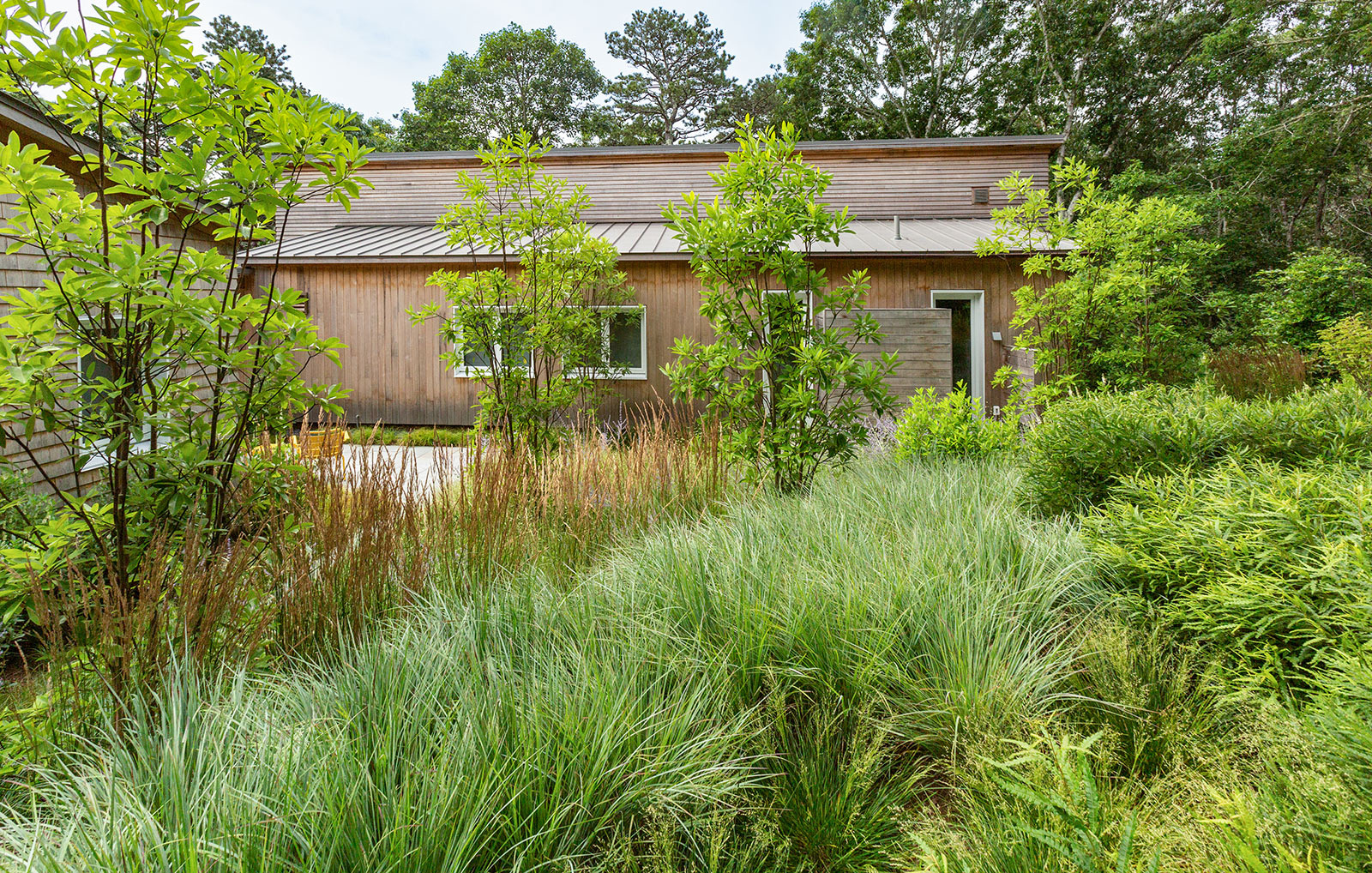There’s something romantic about driving along the back roads of a small town and being enveloped by the grasses and colorful wildflowers of sprawling meadows. The spattering of colorful flowers, the movement of large swathes of grasses, and the wildlife these spaces nurture speak intimately to something untamed within us all.
Although they make us feel deeply alive, a sprawling meadows of one’s own is out of reach for most of us. And while the growing interest in native plants reflects a desire for a more natural, carefree landscape, the reality of a home landscape planted with all natives can be far from carefree.
We're seeing a trend toward the modern meadow to gain a sense of that unbridled nature on a more manageable scale. Also known as a "stylized meadow," these designed landscapes convey a sense of nature, movement, color, and minimalism to a more contemporary living environment with the use of better-behaved grasses, pollinator-friendly perennials, and intentional planting design.
We spoke with three designers entrenched in the Modern Meadow movement to learn more about the style and how they have implemented the concepts into specific designs. The resulting projects are diverse in style, yet all deliver on the promise of speaking to that wild something within us.
Join us as we explore them all, and learn practical meadow garden design lessons along the way. A list of the best plants for modern meadow gardens awaits you at the end of your three-garden tour. Enjoy!
1. A Mid-Atlantic Modern Meadow
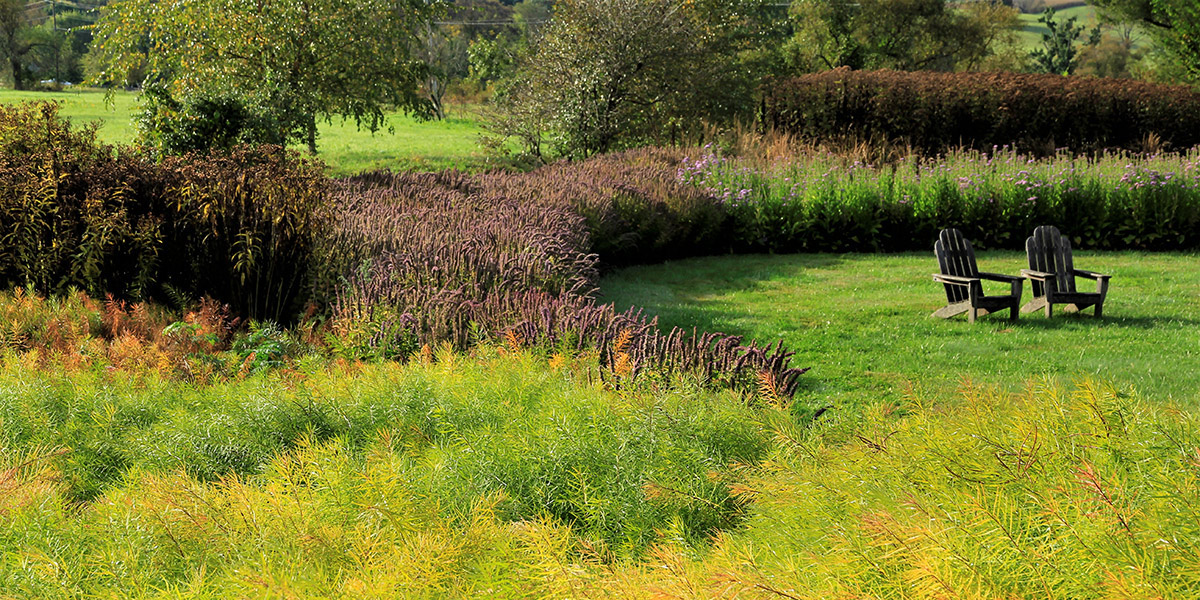
Pell’s Stylized Meadow meets autumn as Amsonia hubrichtii takes on its fall color and the Agastache 'Blue Fortune' and Aster tataricus 'Jindai' turn into structural components.Betula nigra 'Heritage' oversees the meadow in the background.
Donald Pell of Donald Pell Gardens in Phoenixville, Pennsylvania, explains that today’s Modern Meadow style has its roots in the Post World War II era. “Land and park managers had to figure out a way of managing space for people,” Pell says, stating that this was especially the case in Germany and the U.S. where budgets were small and designers embraced the natural landscape. “They found ways to edit and organize the landscape so it became legible for people.” Later, landscape architects such as Roberto Burle Marx and Wolfgang Oehme organized natural-looking landscapes with more of an artful eye.
Pell’s own Modern Meadow design style was influenced by the expansive natural meadows and fallow farm fields that surrounded him as a child. “I really love creating places, even if they're postage-size gardens,” he says. “I very much want to immerse people in a dynamic, immersive, and engaging landscape.”
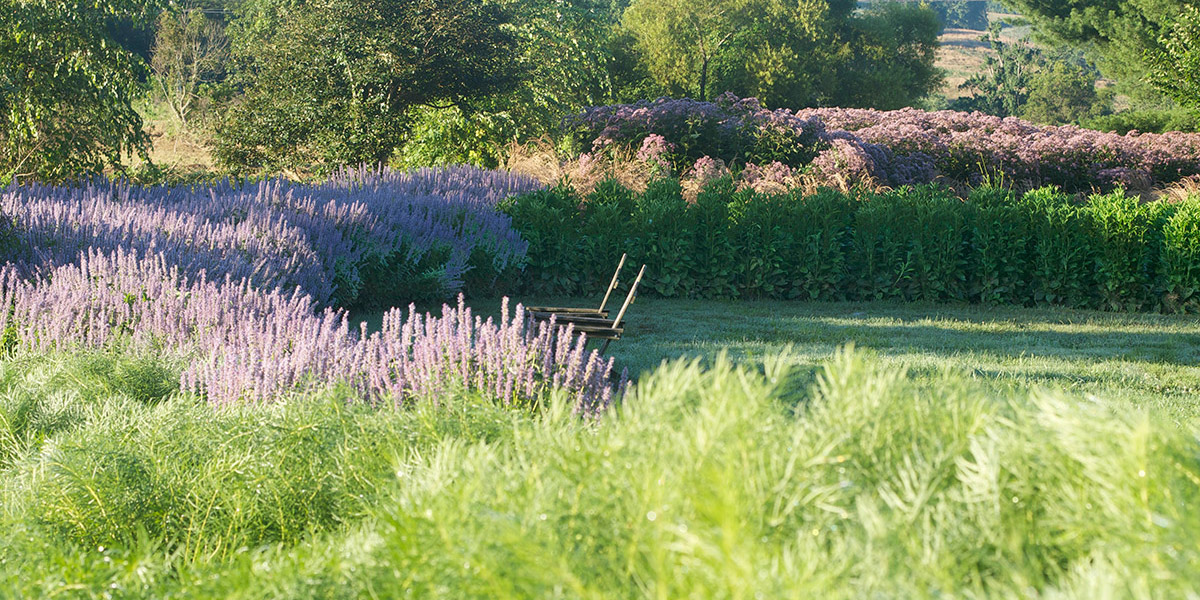
Large swaths of movement are created in this Pell’s Stylized Meadow with mass plantings of Agastache 'Blue Fortune, Amsonia hubrichtii, Eutrochium (Eupatorium) maculatum 'Gateway', and Aster tataricus 'Jindai'.
In his work, Pell aims to create plant communities that are designed to feel natural. For his Stylized Meadow project outside Philadelphia, the client’s property was adjacent to a large nature preserve, and they wanted the garden to feel connected to it, but in a more intentional and impressionistic way. “We organized the plants en masse, so there would be a clarity of design where it still felt loose and natural,” Pell says. This style is very much in the Burle Marx and Oehme vein of planting naturalistic drifts.
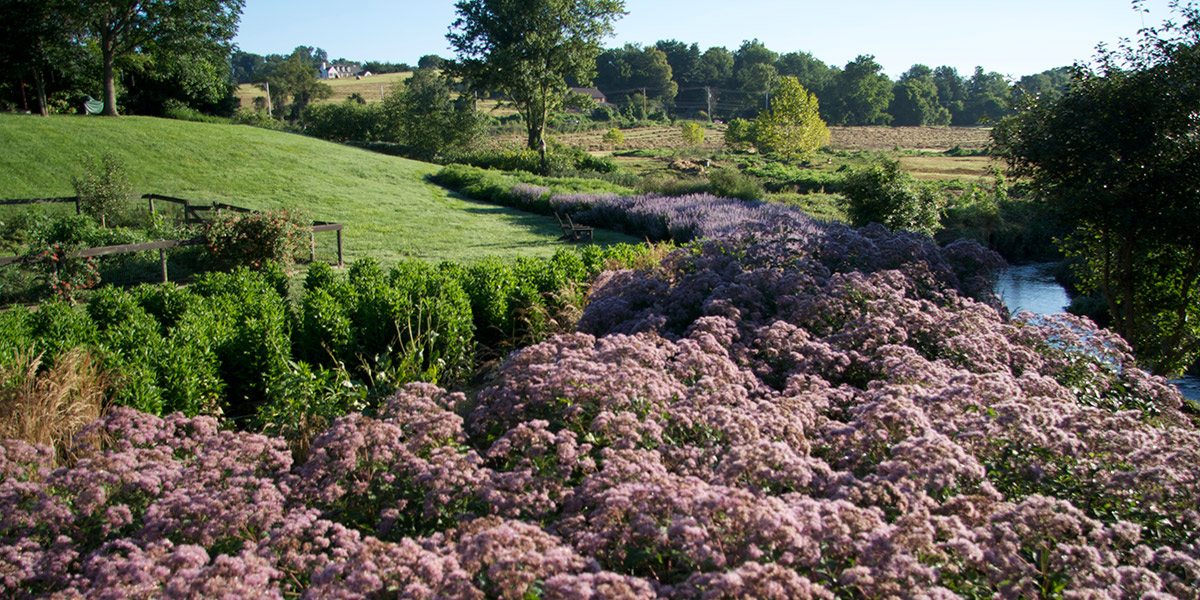
Eutrochium (Eupatorium) maculatum 'Gateway' and Agastache 'Blue Fortune’ create a flowering river, simulating the movement of the adjacent stream.
The impressionistic feel of the garden, which tips the design more toward a work of art than plant placement alone, was created by the intentional underplanting of drifts with dozens of other flowering plants that would create color, texture, and form. The plants used in this project included the native Hibiscus moschuetos, Carex cherokeenesis, Agastashe ‘Blue Fortune’, Scutellaria incana, Eupatorium ‘Gateway’ (now Eutrochium ‘Gateway’), Pycnanthemum virginiamum, Panicum ‘Shenandoah’, and Aster tataricus ‘Jindai’.
When translating a large project like the Stylized Meadow to a smaller footprint, Pell feels many gardeners tend to use smaller plants, and fewer of them. Pell uses large plants and purposefully places them so that occasional branches and leaves are within the pathways, casually brushing a person walking by. “I like the idea of being immersed in and engaging with the plant material as you walk by it,” Pell says. “It’s a very romantic experience.”
In the end, the best thing you can do as a gardener, Pell suggests, is to put plants in the ground and watch what they do. “Keep adding plants and learning about these landscapes on your own terms, in your own landscape, and in your own soils.”
Bonus Pro Tip: Within a larger swath of a particular plant, Pell will mix in a small number of the same plant with a slightly different flower color or hue. To Pell, this mimics genetic variation within a natural population and adds in depth and texture.
Donald Pell’s Go-To Plants for Modern Meadows:
- Geranium ‘Max Frei’ or ‘Rozanne’
- Perovskia ‘Blue Jean Baby’
- Panicum ‘Shenandoah’
- Allium ‘Windy City’
Find more plant recommendations for meadow gardens below.
2. A Cape Cod Landscape that Blends into Nature
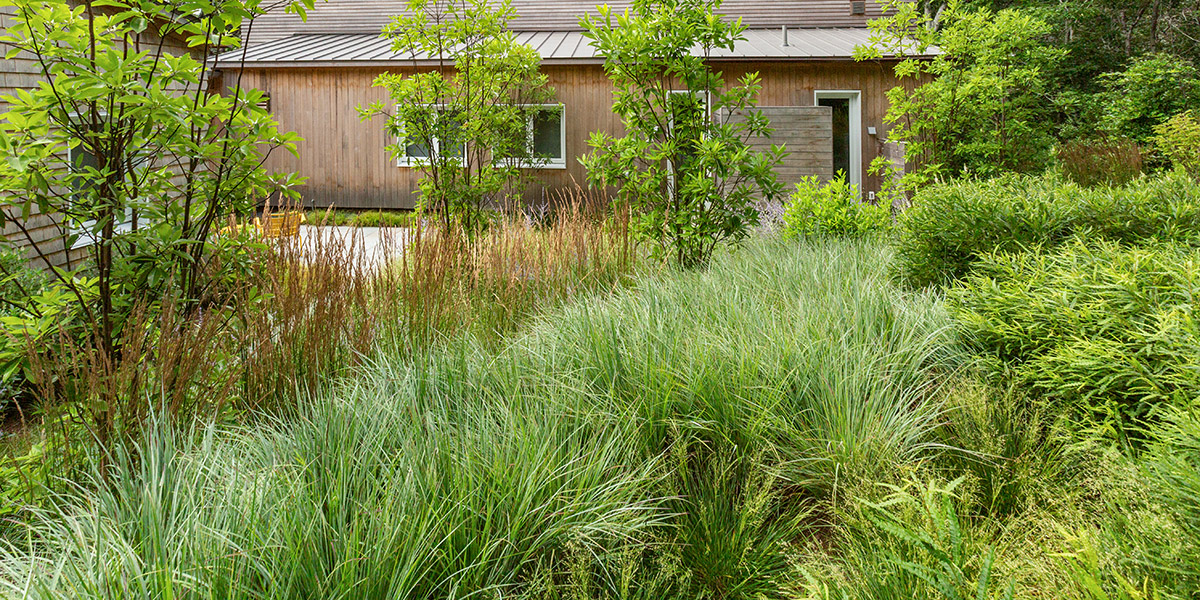
Many of the same grasses flanking the stairs going from the car park up toward the house are also present in the courtyard garden, especially the Sweetfern which is also present in the adjacent forest.
Keith LeBlanc of LeBlanc Jones Landscape Architects, Boston, Massachusetts, believes the Modern Meadow movement has in part grown from homeowners being more conscious of the natural resources required to maintain a lawn. “Gardens don’t always replace lawns,” LeBlanc notes. “The next level up is an unmown lawn or meadow that you can still maintain by mowing it once or twice a year, while still having a low groundcover open space.” LeBlanc noted that what direction a homeowner goes in from a lawn—meadow or garden—often depends on where the property is sited. If near a natural space such as a woodland or conservation area, a Modern Meadow would tie your space into the adjacent land in a much more succinct way.
Clients are also looking for a garden that is low maintenance and are finding that Modern Meadows fit the bill with just one or two mowings per season. Plus, these landscapes also provide natural resources for pollinators and wildlife.
The Modern Meadow LeBlanc created for a Cape Cod property was in response to both the request of his clients for a low-maintenance property and also the dictates of the location. The home’s construction required that they grade the site, place the turnaround and parking area off to the side, and conduct a fair amount of repair work to the area surrounding the home. The Modern Meadow surrounds a courtyard and frames the view of a pond above which the house sits.
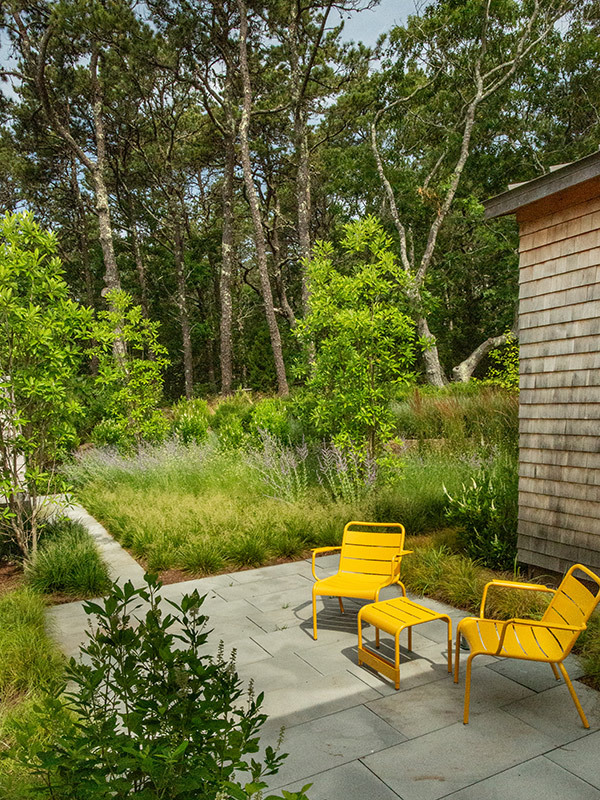
Several Magnolia virginiana rise up from the Modern Meadow surrounding this Cape Cod courtyard, which also includes Blue Grama Grass, Feather Reed Grass, Pennsylvania Sedge, Sweetfern, and Gold Dew Tufted Hair Grass, with Russian Sage added in as a “little garden moment.”
“We were conscious of bringing in smaller plants,” LeBlanc says. “These trees are all Magnolia virginianabecause we wanted them smaller in scale than the oaks and pines that are surrounding this,” LeBlanc explained. “We didn't want anything that large right next to the house. These also bloom, and they have a wonderful fragrance when walking across this courtyard.”
They added in some Clethra, as well, and some native and non-native grasses— Blue Grama, Feather Reed Grass, Pennsylvania Sedge, Sweetfern, and Gold Dew Tufted Hair Grass—all of which are low maintenance and ideal for a graded slope. “In with these grasses, we’ve added Russian Sage as a little ‘garden moment’ mixed in. The Sweetfern grows in the woods here, as well. In that way, again, this is a blurring of the edge of the garden. When does the garden take over the native groundcover, and vice versa?”
The home’s graded front, accessed by the parking court, has many of the same grasses flanking the rising stairs as are present in the courtyard garden. “This was seen as one garden moment, if you will, repeated by many of the same grasses in the next garden moment in the courtyard,” LeBlanc explains. Continuity and repetition work together to establish a sense of place, an important concept with a design that contains several distinct spaces.
3. A Dry Climate Modern Meadow
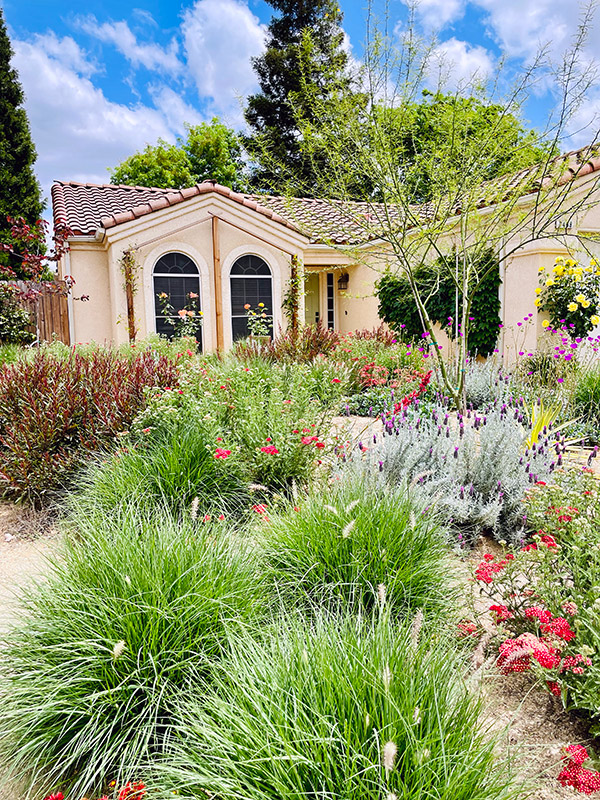
Other than the request to keep the existing trellised yellow roses, Pratt’s clients wanted a low- to no-maintenance landscape. The assortment of plantings—Pennisetum ‘Hameln’, Yarrow ‘Paprika’, Spanish Lavender ‘Ghostly Princess’,Rock Purslane, and Gaura—can simply be cut back in late winter. Notice how the Yucca ‘Brightstar’ ties the nearby yellow rose into the design.
What comprises a Modern Meadow changes with climate and location. In California’s Central Valley, high temperatures and low moisture dictate the plant palette available to create that “better behaved” meadow design. For instance, in the work of Lauren Pratt of Pratt Landscape Design, Agave and larger succulents fill the structural role that boxwoods and other evergreens might in a more traditional cottage or meadow garden.
Pratt’s design style was heavily influenced by the work of Dutch designer Piet Oudolf. “His naturalistic garden style has influenced so many of us over the years,” Pratt says, “and we've started making that style our own, depending on where we live.” Oudolf may be considered the father of the meadow style, she adds, and now legions of today’s designers are modernizing it.
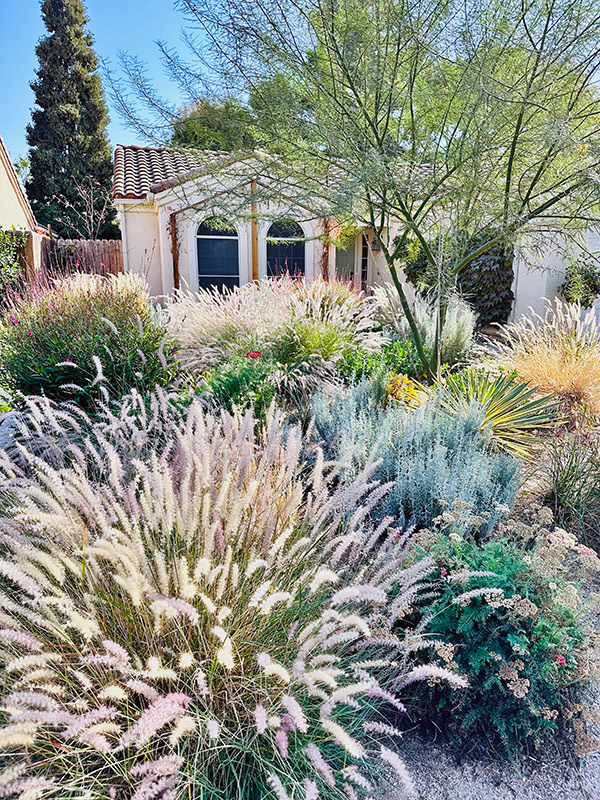
As Pratt’s Modern Meadow transitions into fall and the fancy flowers have faded, grasses burst forth with their fuzzy seed heads. This is the season when texture and movement prevail in the garden.
In Pratt’s designs, fountain grasses and their “big wavy textures” are a must. “Flowers had been a garden’s focal point, and now the more modern garden has a lot more grasses than flowers,” Pratt explains. “What makes a Modern Meadow ‘modern’ is a simpler plant palette, with fewer types of plants but more structure and texture.”
Much of what Pratt designs will feature plants that don’t recede but also don’t self-seed. This cuts down on weeding and unintentional spread, especially for the grasses. Sterile grasses feature prominently in her designs, as well as perennials. “You get a lot of bang for your buck,” Pratt says of grasses and perennials, “because they grow so fast and really fill in.”
The clients in Pratt’s Modern Meadow suburban residential design had only two requests—leave the yellow rose topiaries near the home and remove the lawn. Other than that, Pratt had full creative license. “We wanted to design for drought tolerance and the lowest possible maintenance,” she explains, “but we also wanted a lot of color and texture.”
The design incorporates Gaura, Yucca, Yarrow, Pennisetum, Spanish Lavender, Rock Purslane, Agave, Kniphofia, Senecio, Hesperaloe, Gaillardia, Palo Verde, and a Merlot Redbud among others. After installation of the plants and a drip irrigation system, a 3 in. thick layer of decomposed granite (DG) was laid over the 900 sq. ft. front yard. The DG smothers most weeds, and the clients trim their Modern Meadow just once a year in late winter. “That’s it,” Pratt says, “and it just pops right back up.”
Aside from the once-a-year maintenance, the beauty of this Modern Meadow is that everything blooms at different stages, and the colors change throughout the season. As one plant hides, another plant will bloom. And when nothing is in bloom, Pratt says, “the garden still has character and interest, even when it's all starting to die back.”
Modern Meadow, West Coast Style
Lauren Pratt has noticed a few elemental differences between her work and that of designers in the Midwest or East Coast. These include:
- A hotter, desert-like color palette
- Crushed rock as a mulch rather than compost or humus
- Large succulents as structural elements rather than evergreens
Best Plants for a Modern Meadow Garden
These three designers prove that creative riffs on the Modern Meadow style abound—and are encouraged! From a large property to a residential street, the style’s elements of movement, color, and simplicity can be adapted to any size and preference. We’ve assembled a list of Monrovia plants that suit a Modern Meadow to get you to the starting line of your new design.
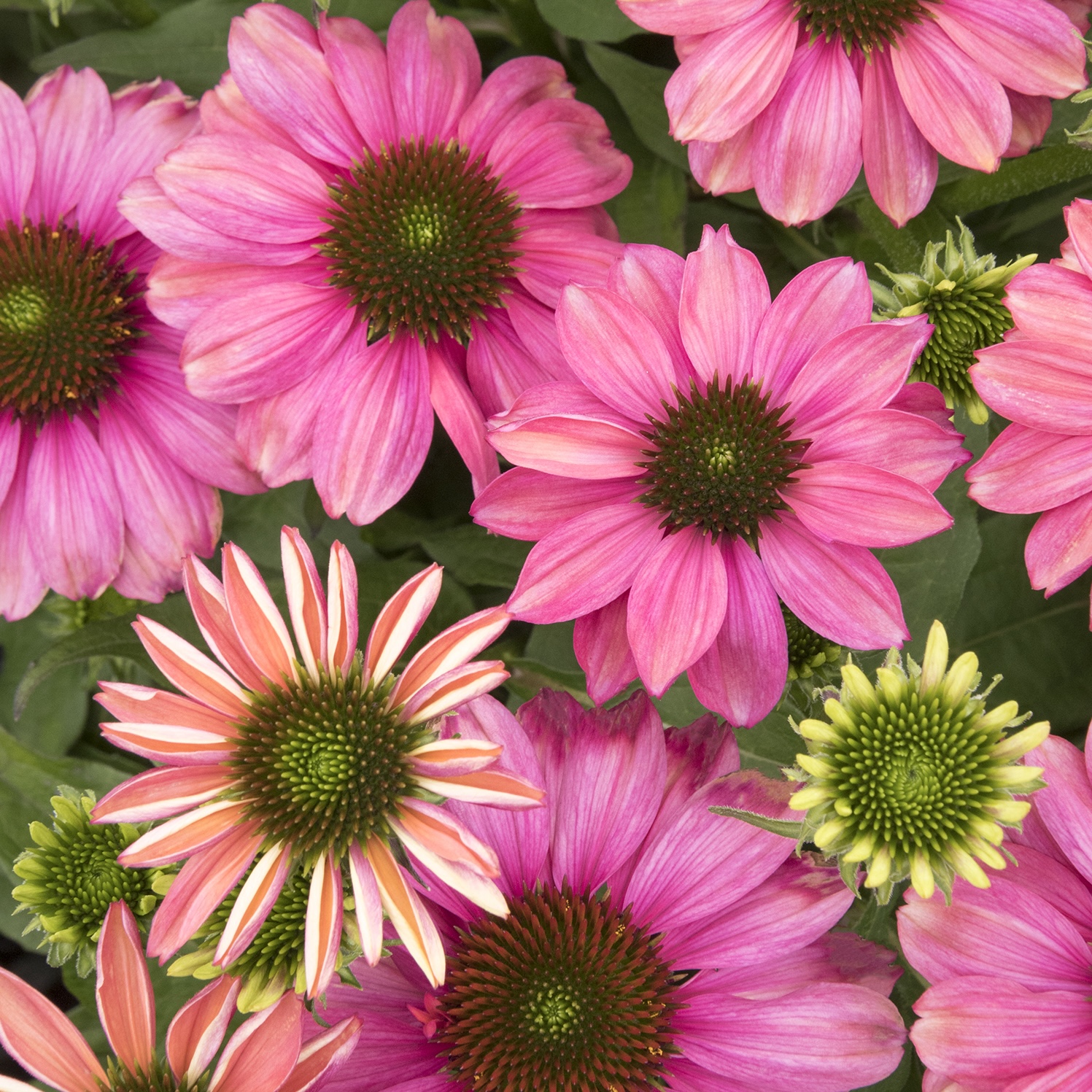
Evolution™ Colorific™
Coneflower
An enchanting green cone at the center of every bloom framed by dense petals in a lovely palette of pink hues. Lush foliage and sturdy, upright stems create a beautiful backdrop for the continuous profusion of blooms from late spring through fall. Full sun. Up to 20" tall, 18" wide. Zones 4-10.
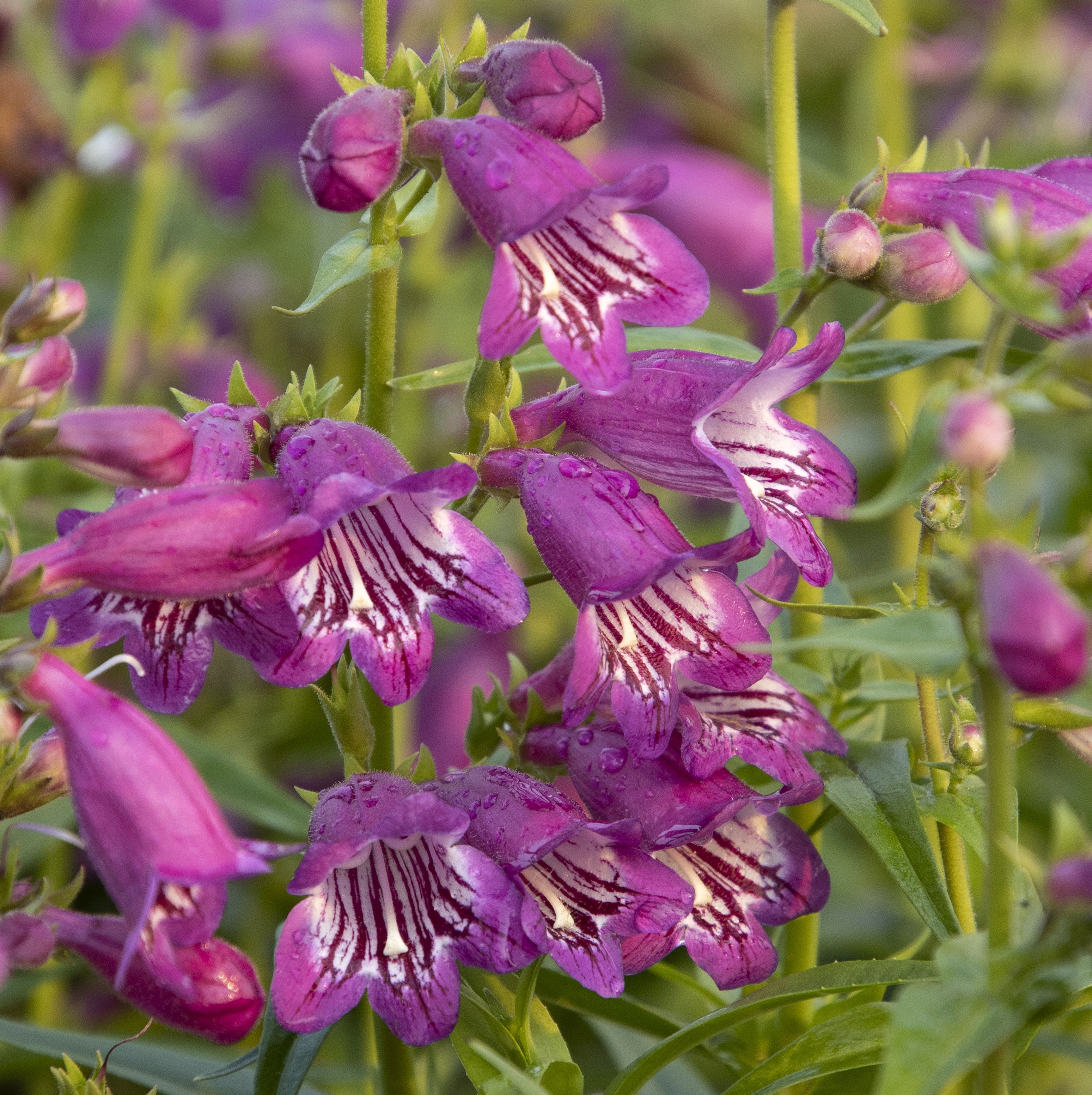
Harlequin™ Purple
Beardtongue
Long-blooming, showy, abundant spikes of large purple flowers are a valuable nectar source for bees, butterflies, and hummingbirds. The vigorous, bushy, compact habit makes this a great plant for perennial borders, rock gardens, and containers. Part to full sun. Up to 22" tall, 16" wide. Zones 5-9.
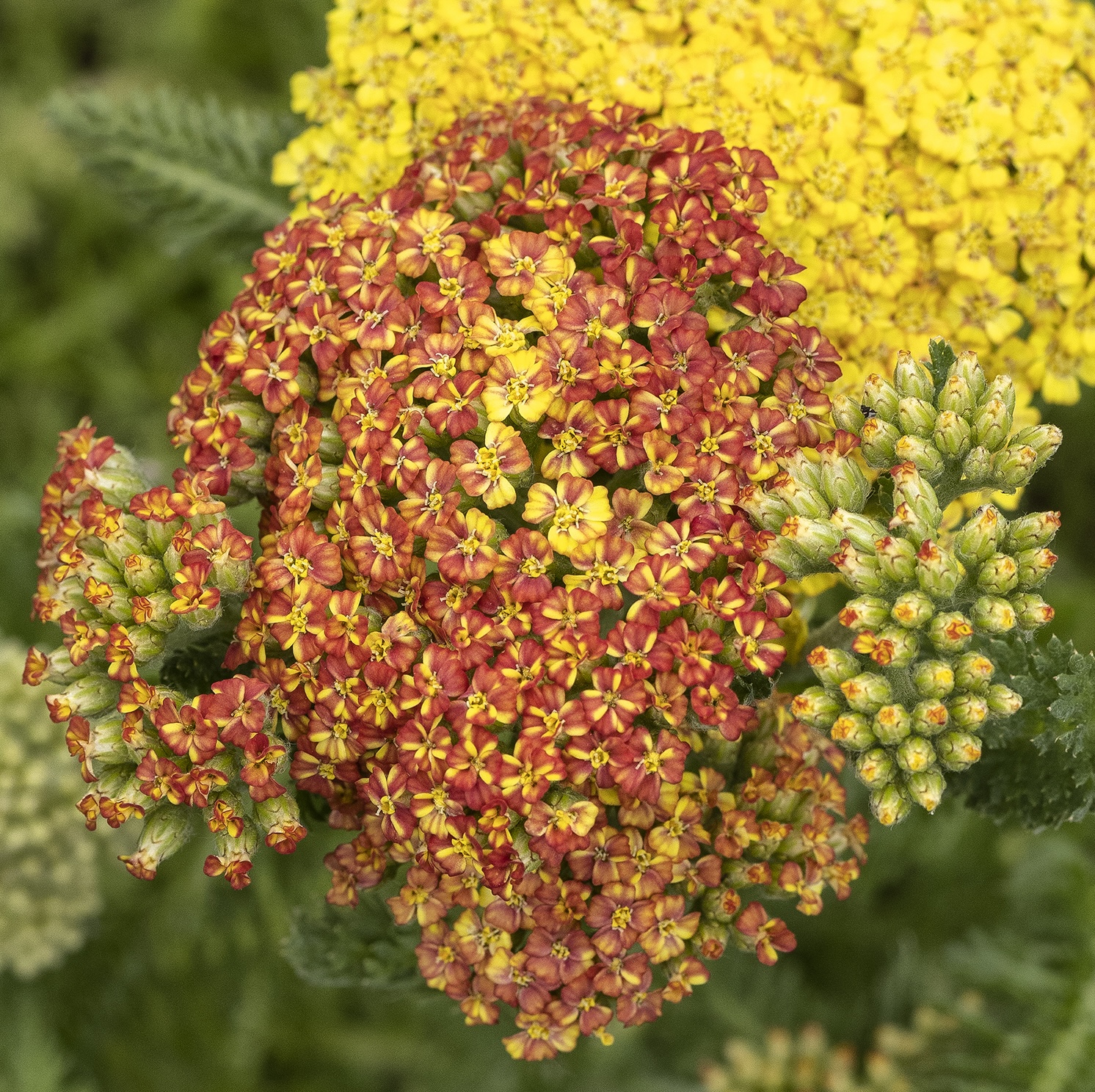
Desert Eve™ Terracotta
Yarrow
This rugged, cold hardy North American native grass features blue-green foliage and striking, flag-like, golden summer flowers on stiff, weather-resistant stems. Tolerant of many soil types, this is a perfect choice for low-maintenance meadow landscapes. Part to full sun. Up to 3' tall and wide. Zones 4-9.
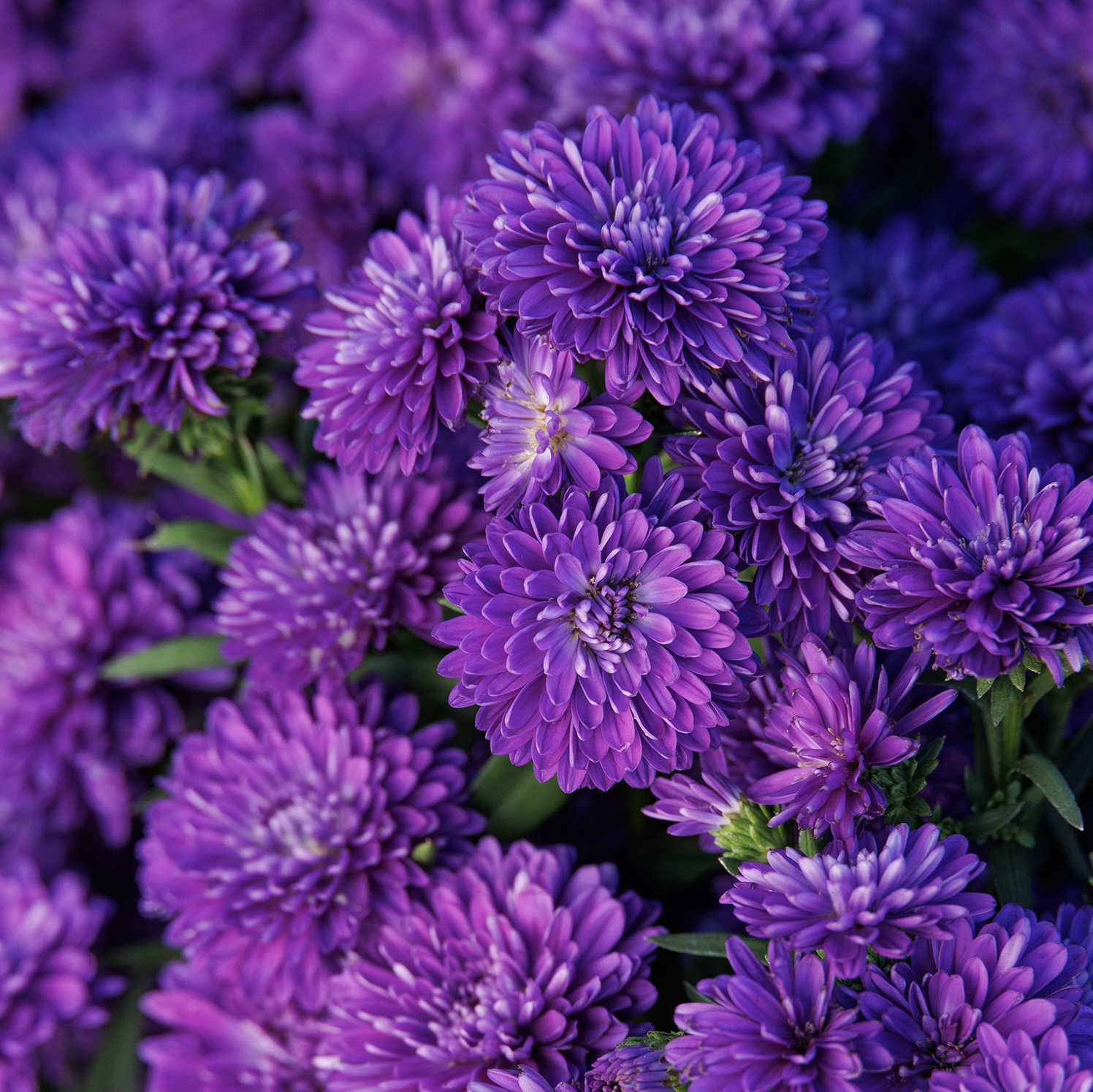
Showmakers® Blue Bayou
Aster
Violet-blue flowers have petals so abundant, they almost form a pom-pom shape. Adds intense color to the late-season garden. Compact and bushy, filling out a container well on its own. Also excellent massed in a perennial bed. Part to full sun. Up to 1' tall and wide. Zones 4-8.
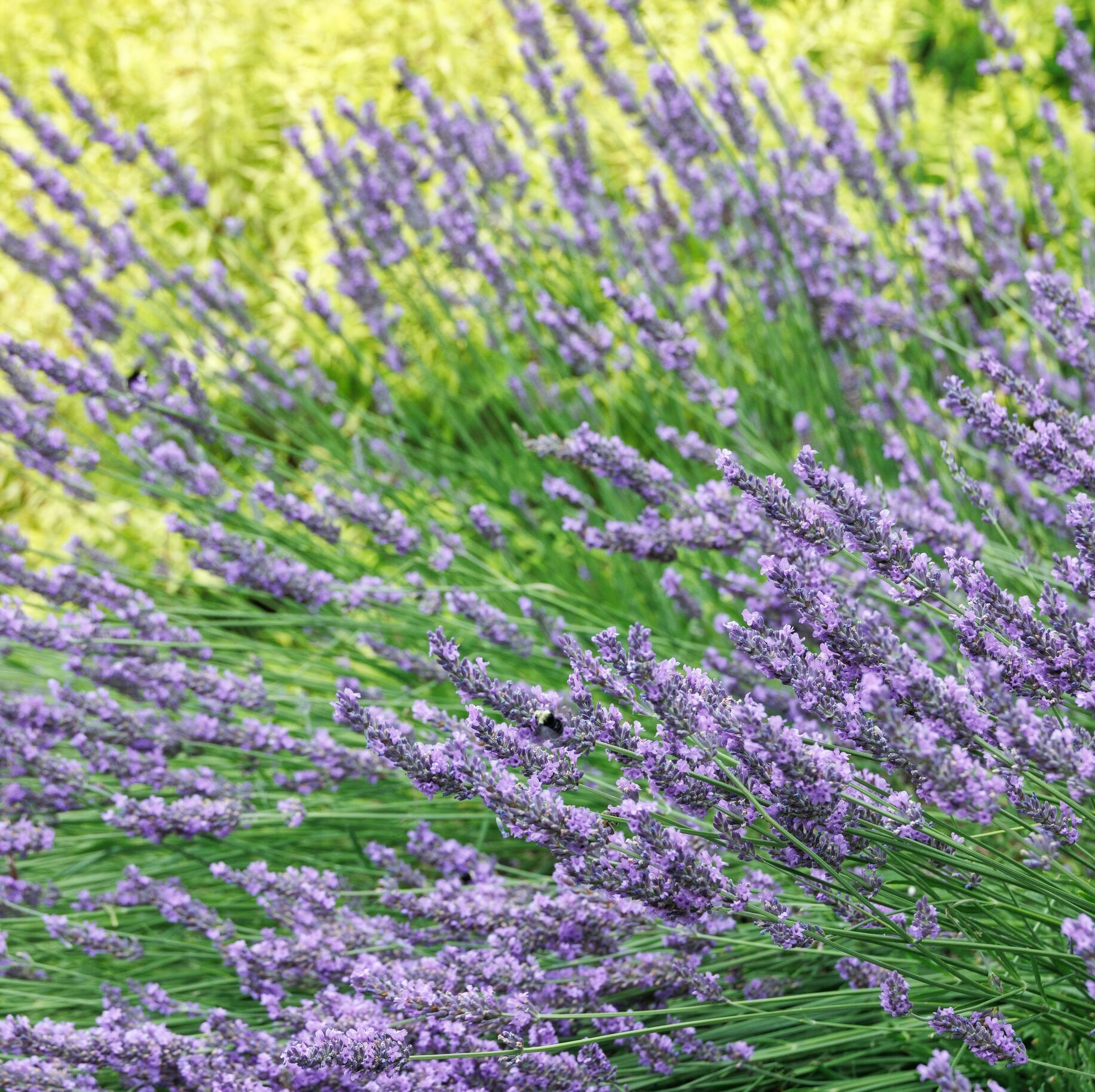
Phenomenal
Lavender
Elegant, sweetly fragrant mounds of silver foliage yield purple-blue flower spikes with outstanding ornamental and edible qualities. Cold hardy, with good disease resistance and heat and humidity tolerance. Loved by pollinators. Full sun. Up to 3' tall and wide. Zones 4-9.
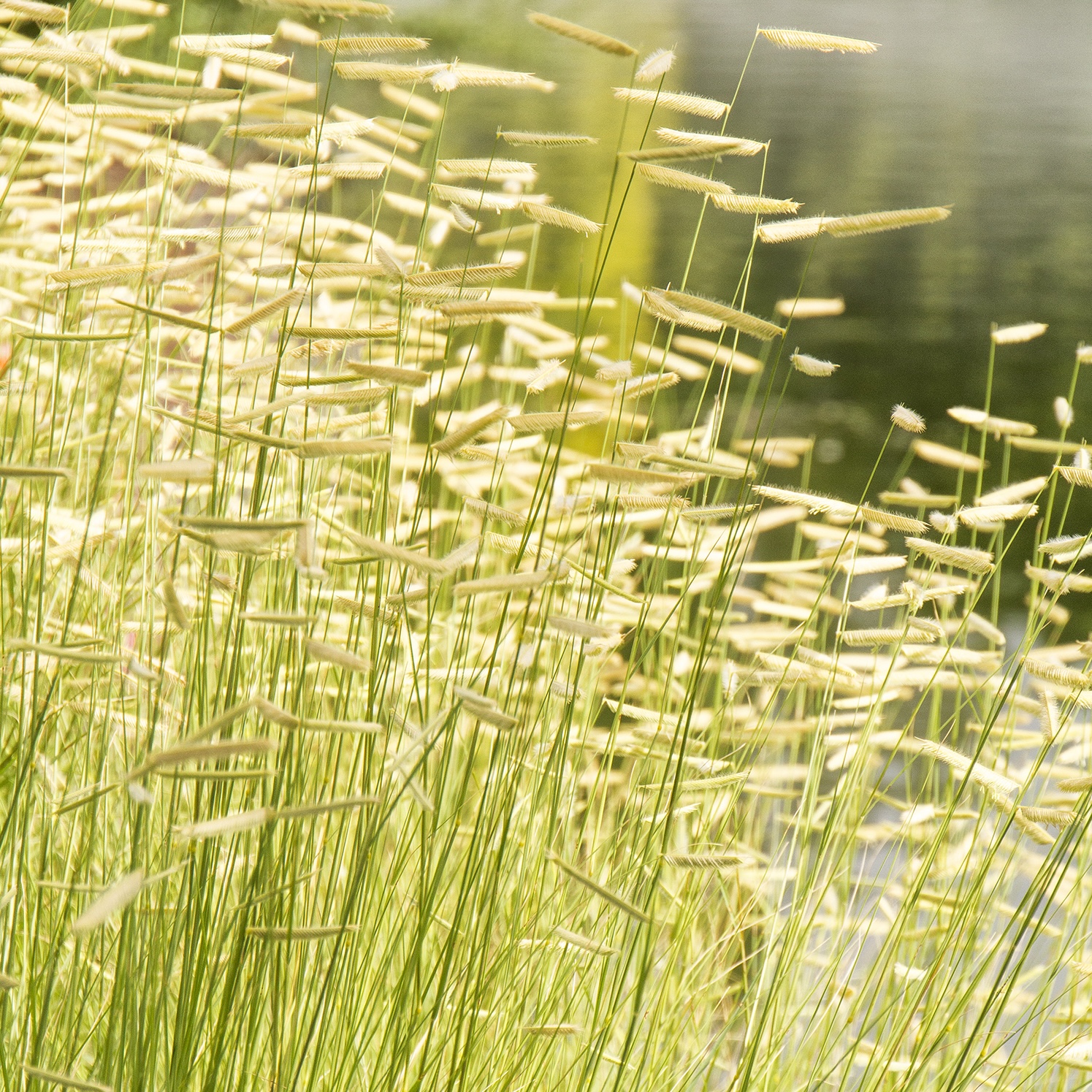
Blonde Ambition
Blue Grama Grass
This rugged, cold hardy North American native grass features blue-green foliage and striking, flag-like, golden summer flowers on stiff, weather-resistant stems. Tolerant of many soil types, this is a perfect choice for low-maintenance meadow landscapes. Part to full sun. Up to 3' tall and wide. Zones 4-9.
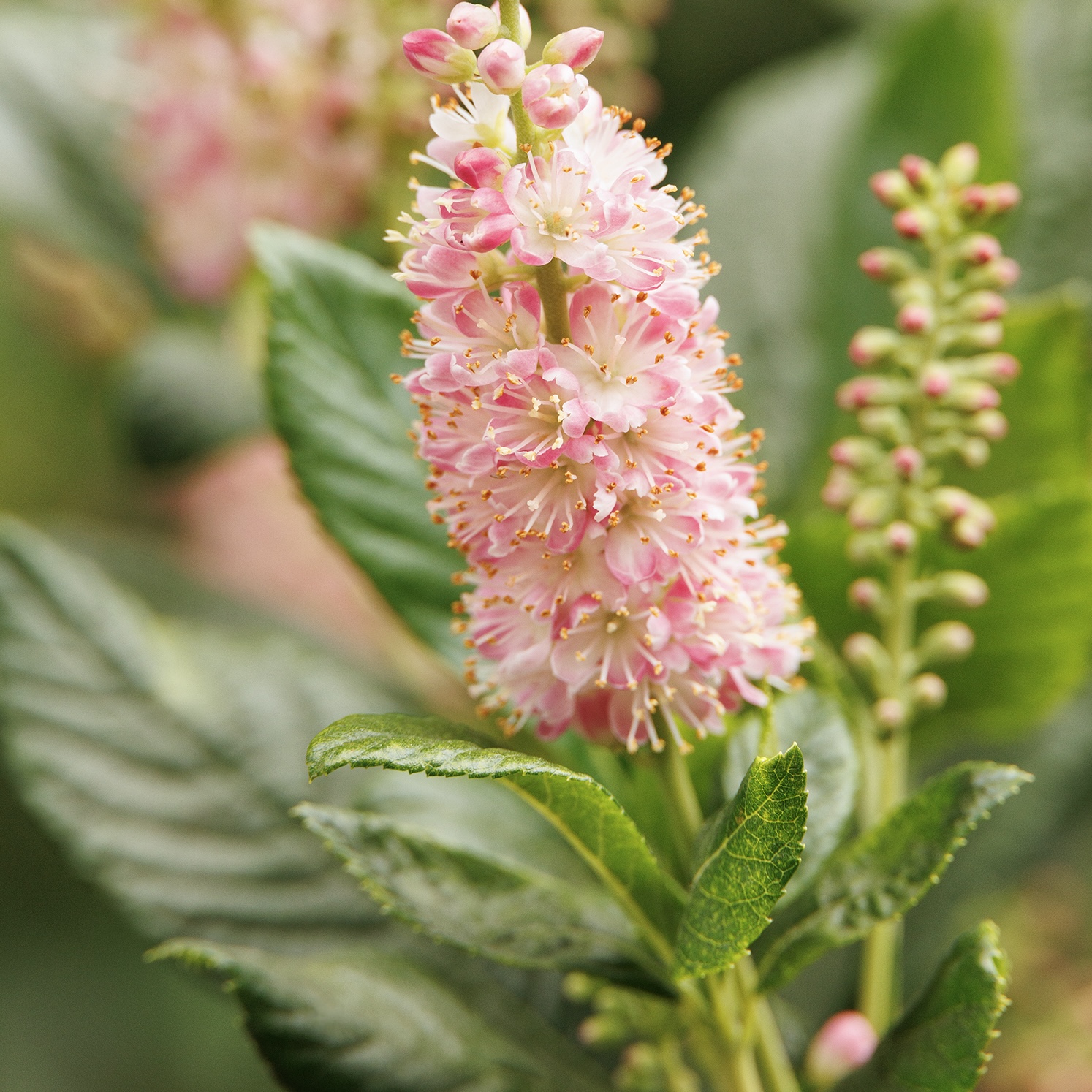
Ruby Spice
Summersweet
Fragrant spikes of small rich rose-pink flowers stand above glossy green foliage. This hardy, versatile plant is fabulous as a focal point or planted en masse at the back of borders. A reliable nectar source for pollinators in the summer. Part to full sun. Up to 6' tall, 5' wide. and wide. Zones 4-9.
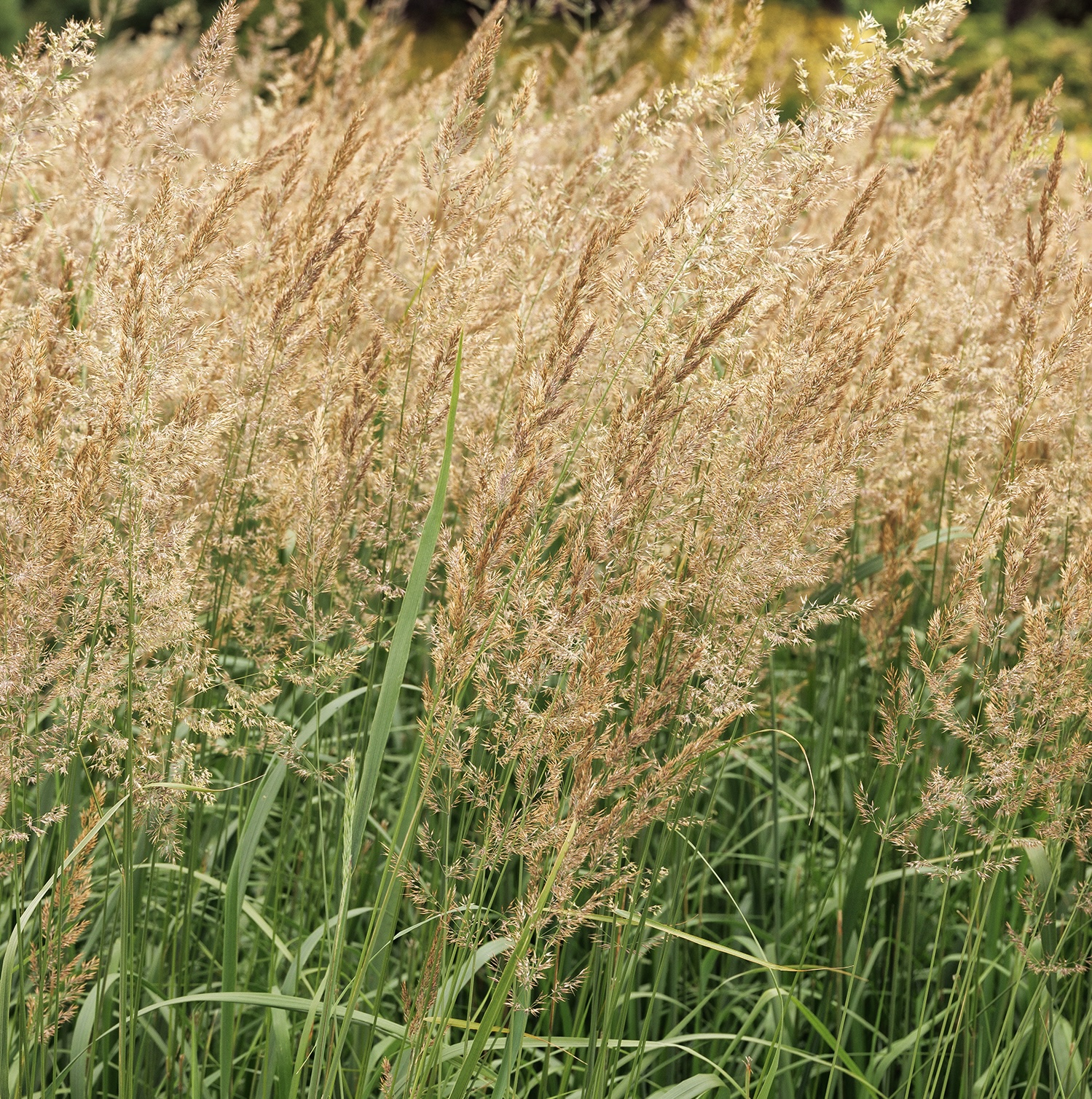
Foerster's Feather
Reed Grass
Create a stunning vertical effect with feathery stalks that emerge reddish brown in spring and turn a rich golden color in fall. Blooms two to three weeks earlier than common feather reed grass. Thrives in wet soils, yet tolerates drier conditions. Sterile seeds. Full sun. Up to 2' tall and wide; bloom stalks reach 6' tall. Zones 4-9.
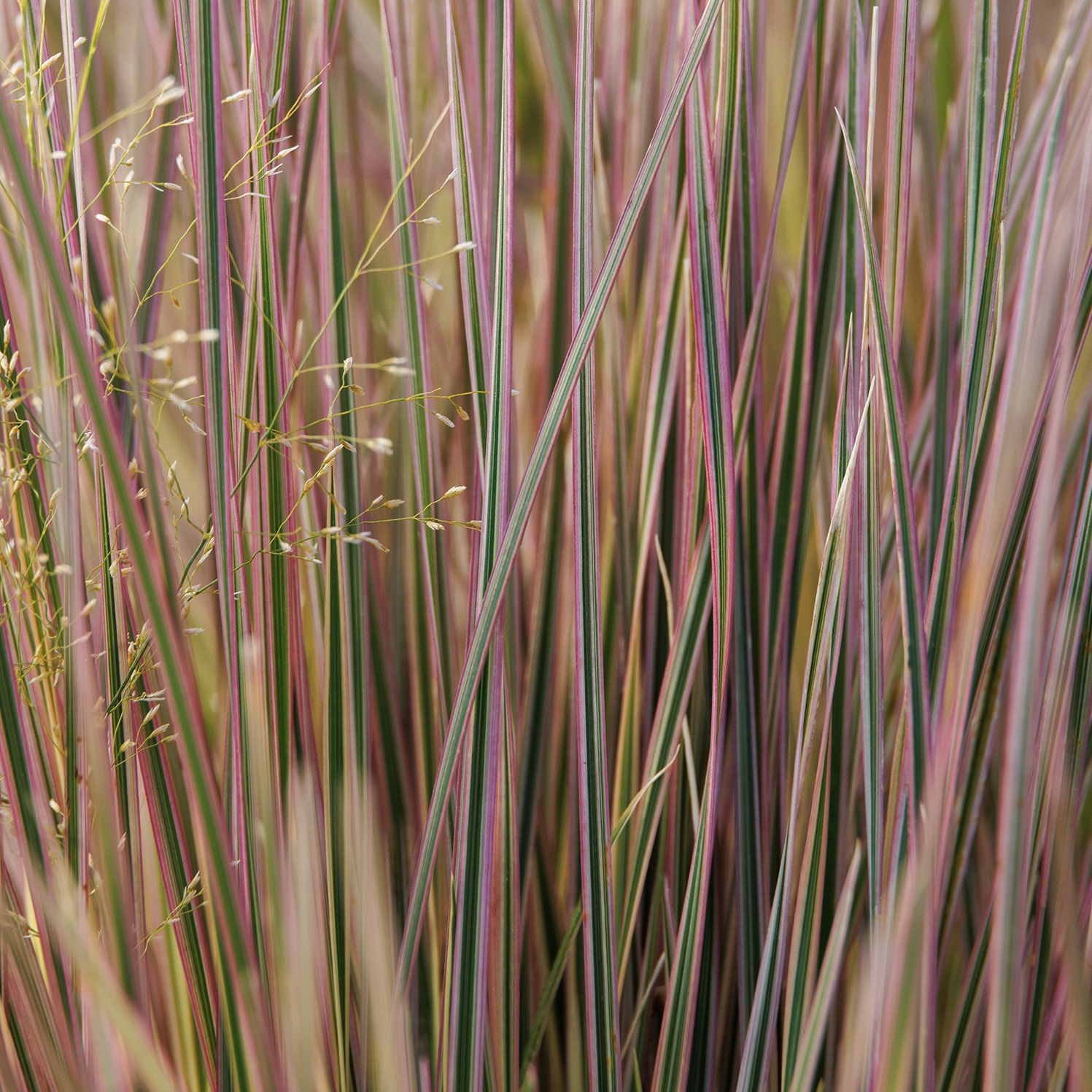
Northern Lights
Tufted Hair Grass
Highly variegated green and creamy white leaves have a rosy pink blush when emerging in early spring and again as the weather cools. Buff-colored flowers provide additional interest. Excellent for use as a small landscape accent, or plant en masse as a highly textural groundcover. Filtered sun. Up to 12" tall and wide. Zones 4-9.
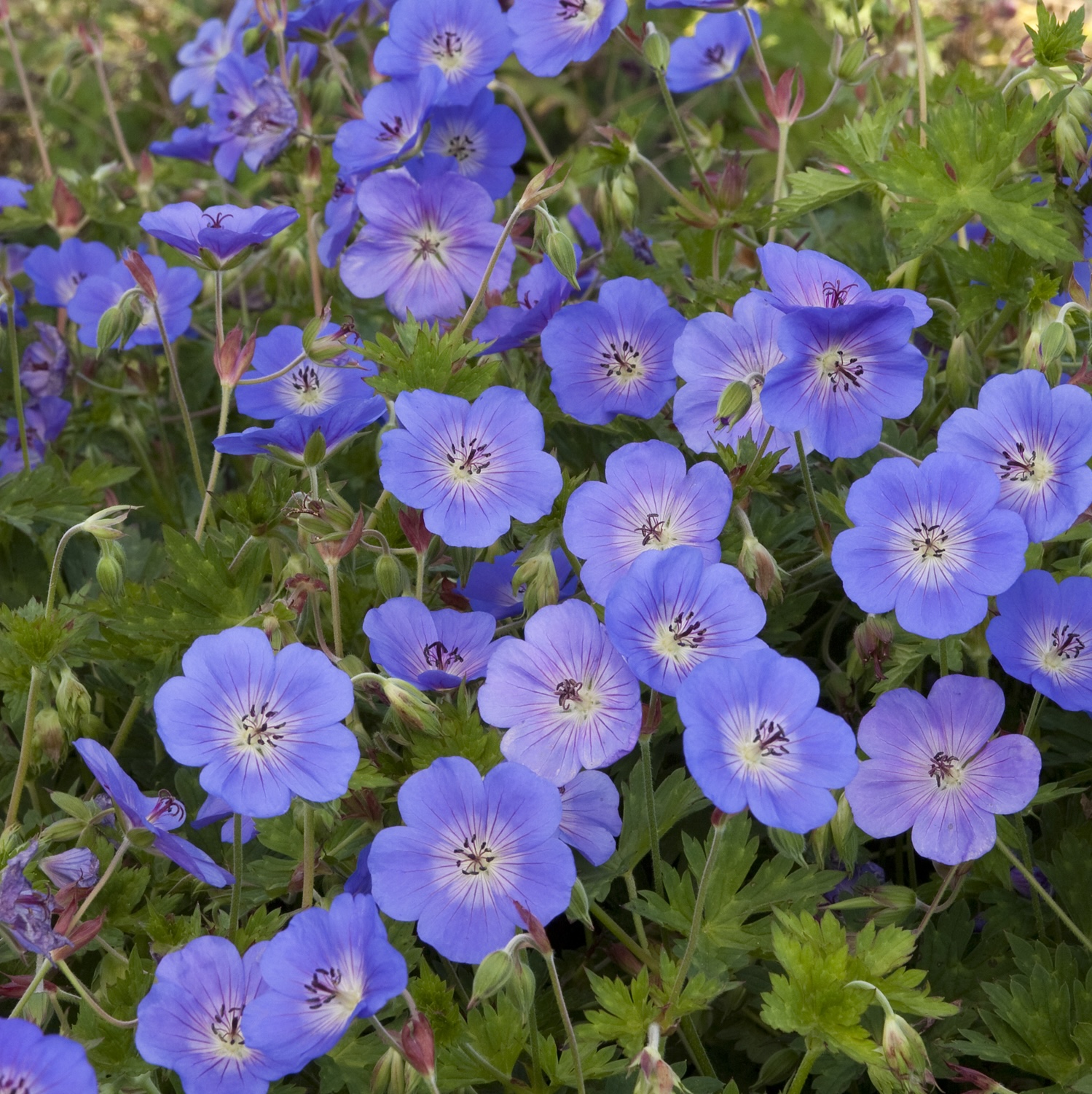
Rozanne
Cranesbill
A great small-scale groundcover for meadow gardens. Dwarf spreading form with dainty violet flowers that show color for many months. Lush mound of deep green foliage is lightly marbled chartreuse. Nearly evergreen in most climates. Part to full sun. Up to 20" tall, 24" wide. Zones 4-10.
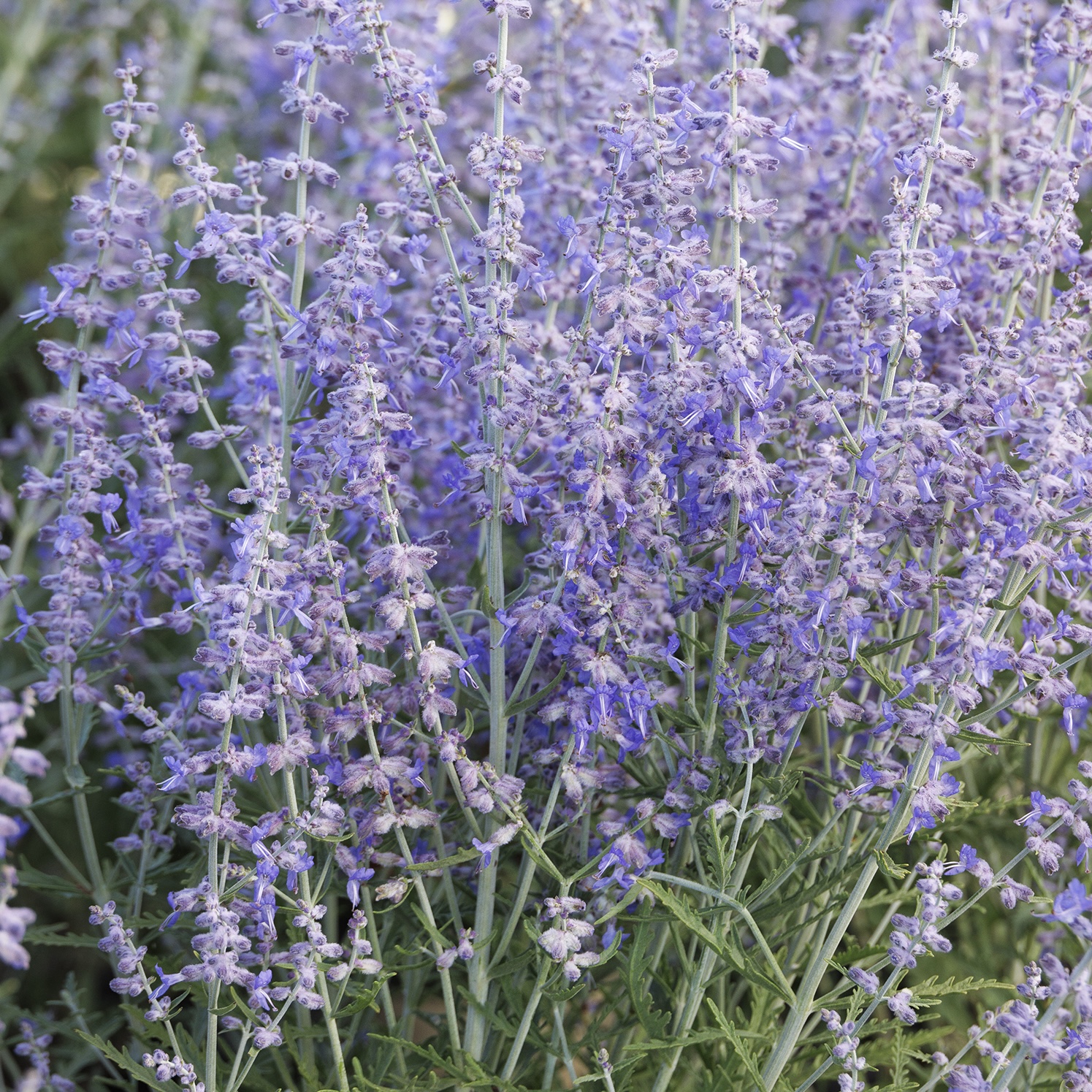
Blue Jean Baby
Russian Sage
A shorter, compact variety that is full and vigorous in the landscape, with upright stems that resist flopping. One of the earliest to bloom, with midsummer lavender-blue flowers and smoky purple calyxes that hold well into fall. Full sun. Up to 3' tall, 3' wide. Zones 4-9.
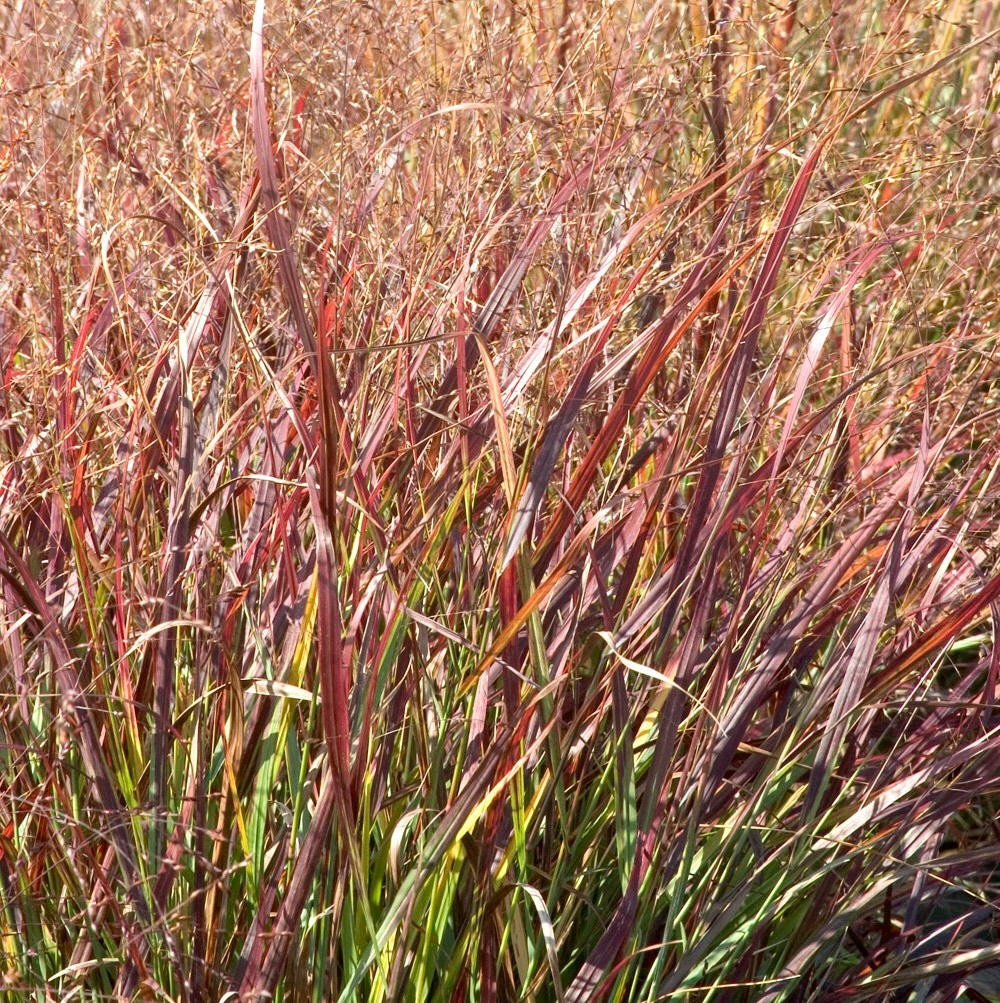
Shenandoah
Switch Grass
Prized for its unmatched foliage color, this handsome grass has fast growing green leaves that emerge with red tips in spring, darken through summer, and turn a rich burgundy in fall. Airy reddish pink flowers develop in summer. Part to full sun. Up to 4' tall, 3' wide. Zones 4-9.
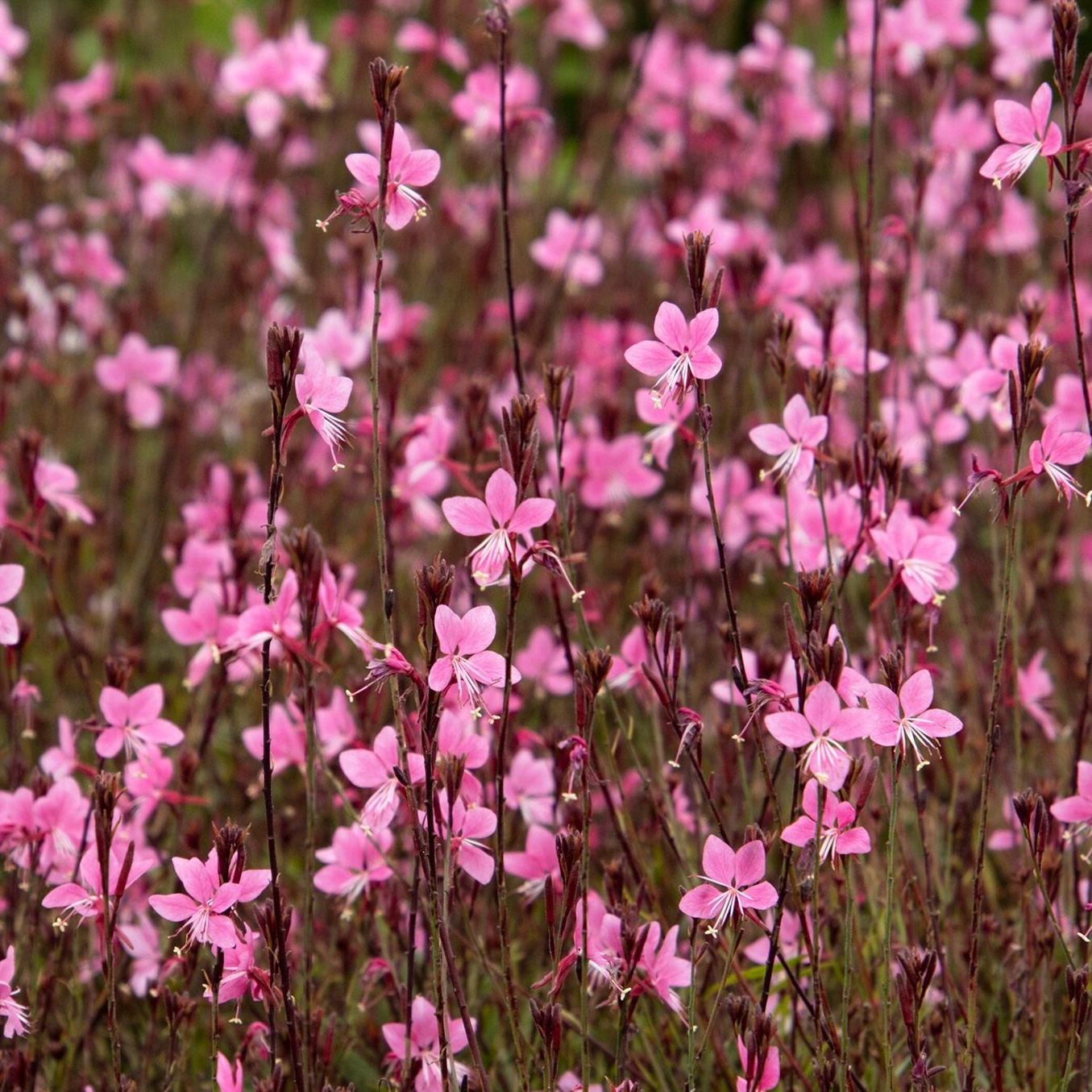
Steffi™ Dark Rose
Gaura
A bushy rounded form with robust green foliage and an abundance of upright spikes blanketed with dark rose-pink flowers. A charming and popular choice for hot, dry regions. Great in sunny borders and rock gardens, and in containers. Full sun. Up to 24" tall and wide. Zones 5-9.
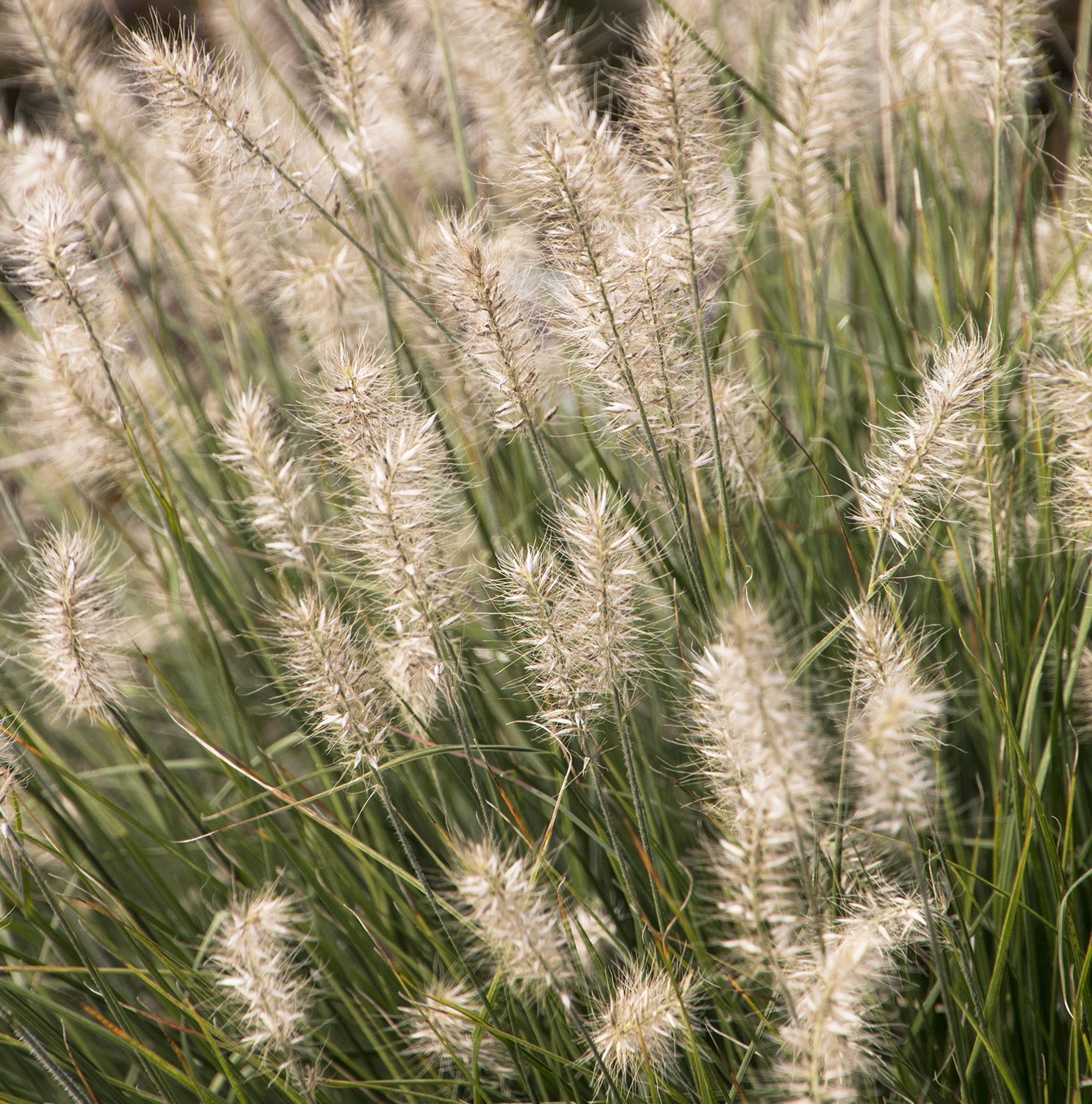
Dwarf Fountain
Grass
An attractive grass highlighted by fluffy, buff-colored plumes that arch above the lush, green fountain of foliage. In fall the foliage turns a lovely golden russet color. Full sun. Up to 3' tall, 2' wide. Zones 4-11.
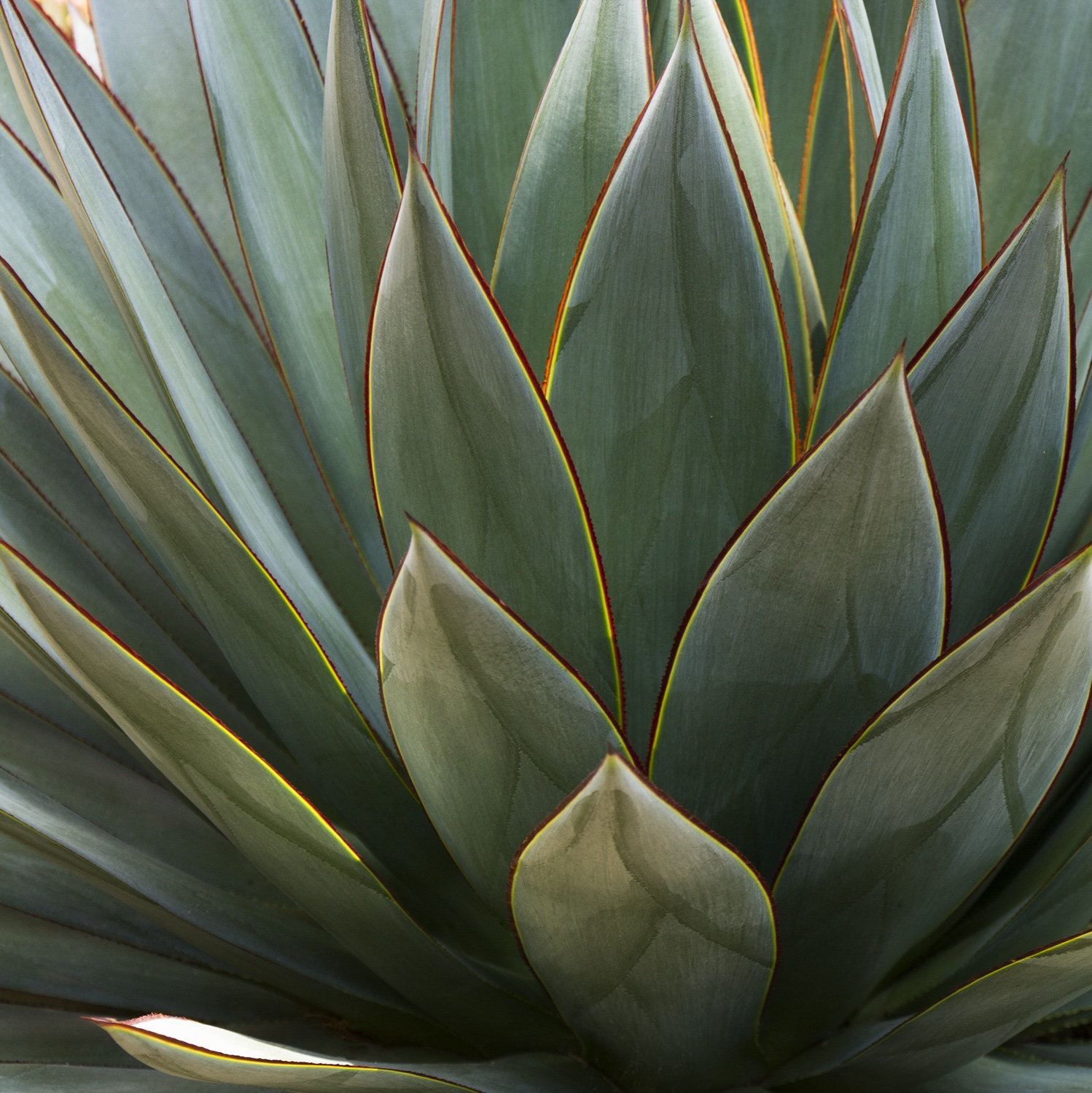
Blue Glow
Agave
Smooth, blue-green leaves with yellow-edged, red margins form a single, symmetrical rosette. Each leaf tip bears a short red spine. A comely choice for sunny, low-water gardens in warm coastal or humid Mediterranean-like climates. Part to full sun. Up to 18" tall, 24" wide. Zones 8-11.
Get More Information About Meadow and Pollinator-Friendly Gardening
- Take a look at the pollinator section of the blog for a variety of stories about pollinator-friendly gardening
- Get 9 free landscape plans and pollinator gardening tips in the Backyard Habitat Guide.
- Modern Meadow: A fresh take on pollinator garden design
- What to Plant to Attract Butterflies, Hummingbirds, and Bees
- Ask an Expert: Best Pollinator Plants for the Garden
- Beneficial Insects for a Healthy Garden: A Visual Guide
- Best Early-Spring Flowering Plants to Attract Pollinators
- 10 Early-Blooming, Cold-Hardy Plants for Pollinators
- Late Summer and Fall-Blooming Perennials
- Grow a Pollinator Border
- Sign up for our Grow Beautifully newsletter. You'll get more design inspiration, garden tips, how-tos, and first access to exclusive guides, webinars, and plants.




